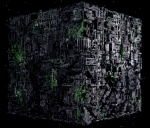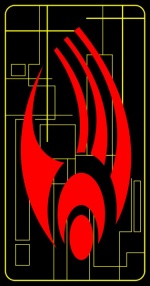Borg
From Star Trek: Theurgy Wiki
The Borg were a pseudo-species of cybernetic beings, or cyborgs, from the Delta Quadrant. No single individual truly existed within the Borg Collective (with the exception of the Borg Queen), as all Borg were linked into a hive mind. Their ultimate goal was the attainment of 'perfection' through the forcible assimilation of diverse sentient species, technologies, and knowledge. As a result, the Borg were among the most powerful and feared entities in the galaxy, without really being a true species at all.
After the transwarp network was destroyed by the USS Voyager in 2378, the Borg was never seen again anywhere near the Alpha Quadrant.
Technology/Physiology
Borg was not something that a person is born to, but rather something that they are forced to become — though for infants and children assimilated by the Collective, they may have little or no memory of any other life. The Borg melded biology with technology, and a drone would have countless implants, the result of both invasive surgery and aggressive nanotechnology. Therefore, the physiology of each Borg drone varied according to the species from which it was assimilated.
Upon assimilation, a drone ceased to grow body hair and developed an ashen, grayish skin coloration, ignoring original skin pigmentation. Cybernetic implants were either surgically attached to the body or grown internally by nanoprobes injected into the bloodstream; in certain cases these implants could cause severe skin irritation. The nature of these implants varied from drone to drone depending on the drone's intended function, but basic nodes of interlink for communications with the Collective and a myo-neural cortical array to control movements were implemented in every drone. In most cases an eye would be replaced with an eyepiece that improved vision and an arm would be amputated altogether to make room for a functional prosthetic; in tactical drones a weapon would be included, and some drones had medical tools built in.
Borg were extremely strong and resilient, owing to their technologically-enhanced physiology. They lack self-determination and intuition, relying on directives and protocols from the Collective, and the gestalt consciousness of countless other Borg drones.
Multi-Regenerative Security Field
A multi-Regenerative Security Field is a type of force field. A force field is an energy shield created made of charged particles, which protects a person, area or object from attacks or intrusions by absorbing or dissipating the energy of the incoming attack; prolonged exposure to such attacks weakens the shield and eventually results in the shield's collapse.
Multi-Regenerative security fields are high-level force fields placed around the most sensitive technology aboard Borg vessels, preventing transporter beams and all matter both biological and technological from passing through. Borg Drones however possessing their personal regenerative shielding are able to adjust their frequency and pass freely through these fields at will. They are particularly good at preventing all-forms of transporter attacks even against the Narrow-Beam transporters designed by the Hanson's which was created specifically to penetrate Borg shielding. Such force fields are able to be erected throughout the entire vessel however they are typically not activated until a threat has already been detected on-board within exception to sensitive areas such as the Central Plexus.
Automatic Regeneration Matrix
The exterior hull armor of all Borg vessels and stations have the capability of regenerating quickly and constantly, granting an enormous boost to survivability in prolonged battles. The exterior of the Cube's hull is covered in pipes and conduits which act like blood vessels and capillaries transporting automated regeneration units to the damaged areas, the A.R.U's work in conjunction with the memory alloy tritanium, the alloy returns the hull armour to its previous structural configuration as best it can with the remaining hull shards and the nanomachines distributed by the automated regeneration units seal together and repair the damaged hull armour. This method grants the vessel the capability of healing much like a biological body would. The creation and distribution of the automated regeneration units are governed by the ship's equivalent of a heart, the Automatic Regeneration Matrix.
Automated Regeneration Unit
Automated regeneration units are completely automated, small, light-weight, spherical droids which are rarely ever encountered - despite numbering in the thousands. They are only present upon the smaller Borg vessels which alone do not possess high enough regenerative capabilities nor a large enough crew compliment to meet the minimum regenerative quota. The auto-regeneration units are there to assist and greatly boost the regenerative, repair and maintenance efforts aboard the vessel. Distributed by the automated regeneration matrix they operate in small sub-junctions, passageways and conduits which are either hazardous to biological matter or inaccessable by drones. Rolling around inside of Borg vessels, their function is to repair all forms of internal damage of which Borg drones themselves are unable to reach. The units are also unbound by the confines of artificial gravity plating - their inner core possesses a freely rotating and extremely strong electromagnet which holds them to the ships metallic tritanium surfaces, allowing them to function even in the unlikley event of a hull breach and allowing the droids to scale walls and travel along ceilings, repairing all ship systems and technology they encounter.
History
Perhaps the most powerful and fearsome foe the Federation and Starfleet had ever faced, the Borg had been silent since the return of the USS Voyager. The Federation had commissioned a new series of deep space probes and listening posts specifically dedicated to monitoring any possible new Borg incursion. Stafleet tended to be a step behind the Borg in most instances, so it was hoped that these probes and posts would serve as an early warning system to give the Federation a fighting chance the next time the Borg invade our space.
The intelligence communities of the Federation, Romulans, Klingons, and Cardassians agreed (shockingly enough) that, now that the Borg knew where they were in the galaxy and what they had to offer, they would not hesitate to come back and attempt the final assimilation of all species within the Alpha and Beta Quadrants. While the Federation had been the hardest hit during the previous Borg attacks, both the Klingons and Romulans had admitted to losses at the hands of the Borg, and there had been reports of independent peoples also suffering under the Borg. If there was one positive note to come from the past Borg attacks, it was that they had forced Starfleet engineers and scientists to get more creative with starship design. There were several new classes of Federation starships, including the Akira, Intrepid, Norway, Saber, Sovereign, and Steamrunner classes. All these ships were developed following the first Borg invasion and Battle at Wolf 359 and carried technological advances sparked in large part by the Borg threat. Hopefully, Starfleet could get enough of these new ships built, manned, and entered into service before the Borg returned.



